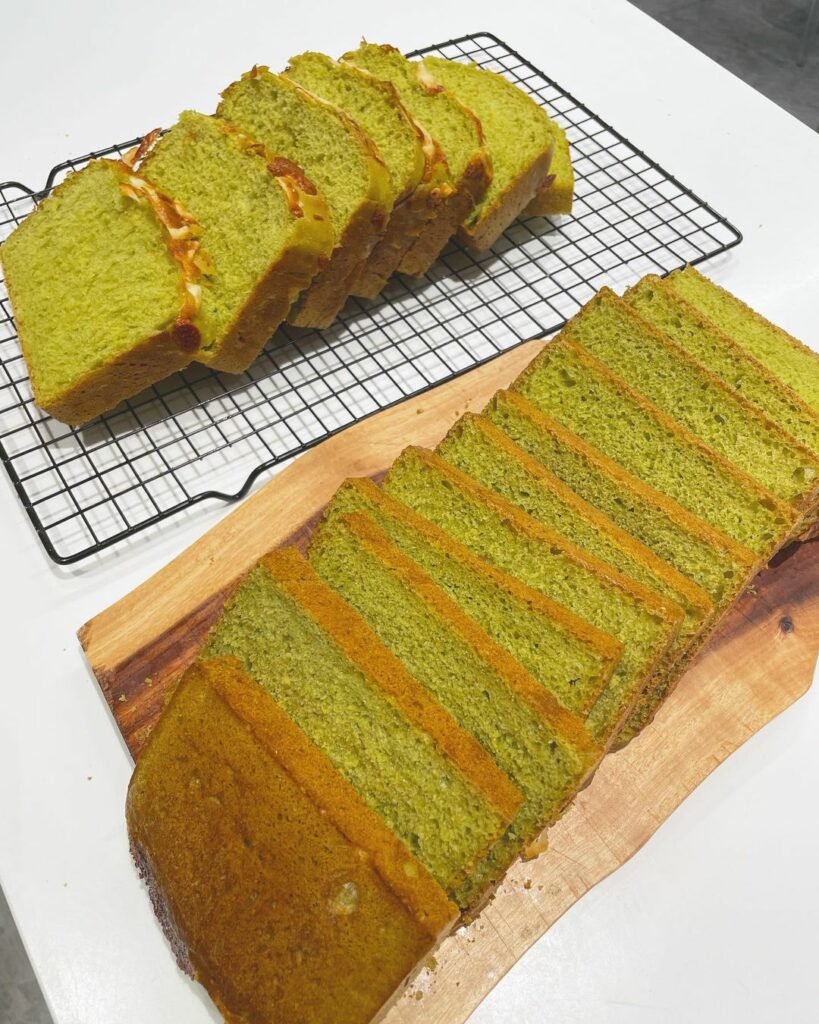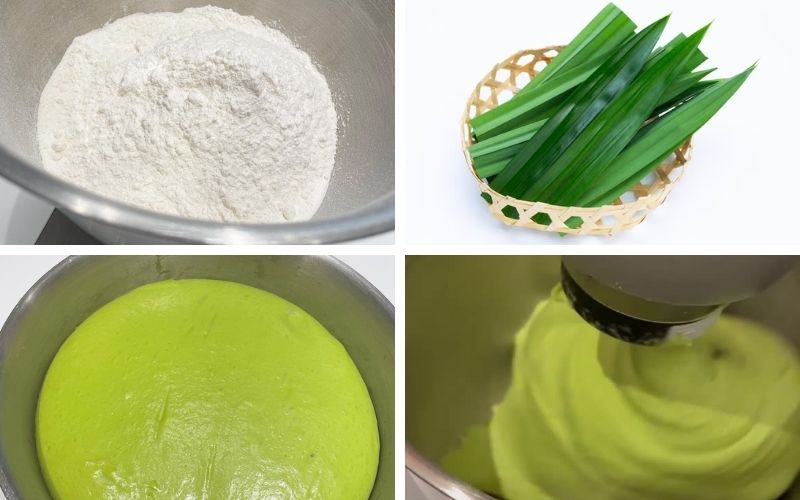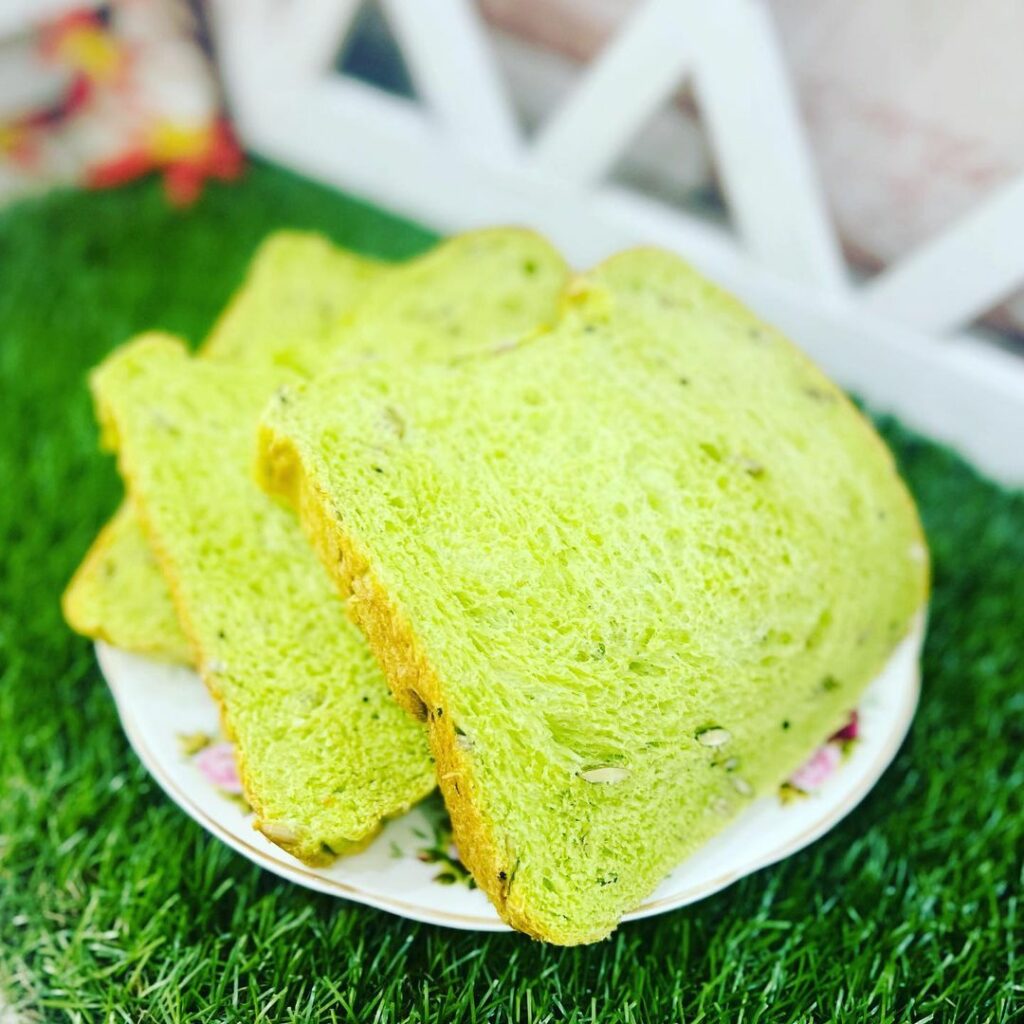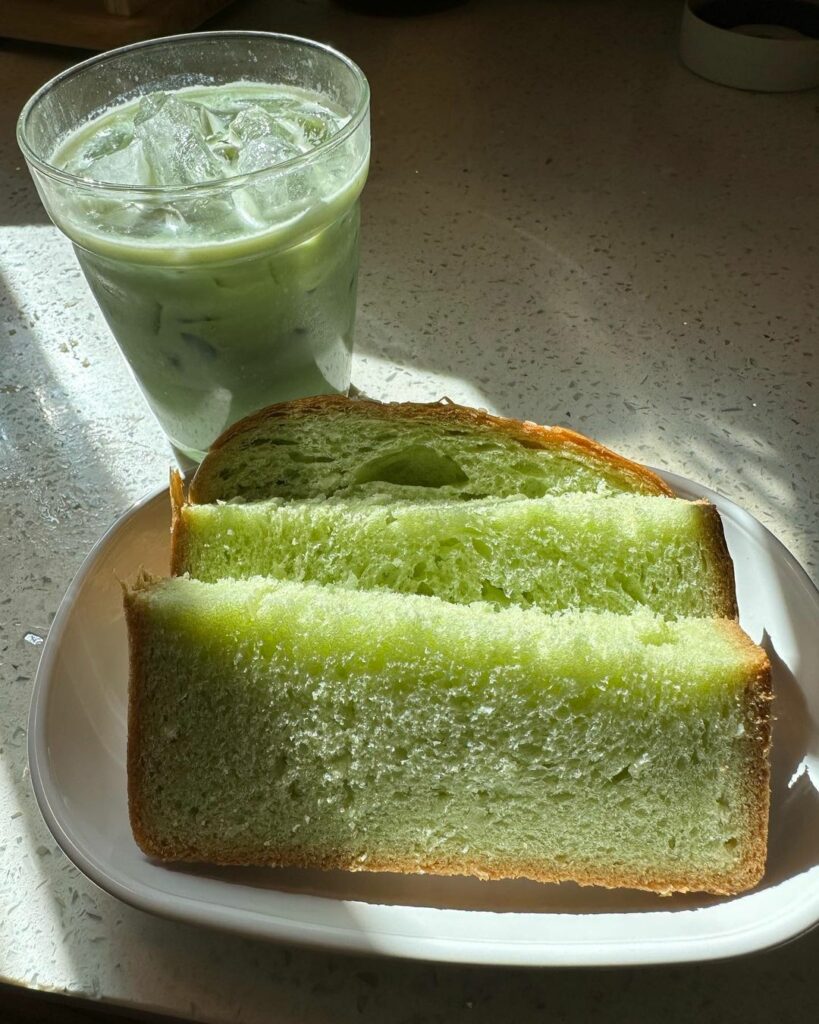Do you love the aroma of freshly baked bread? How about indulging in a unique and flavorful treat that combines the comforting familiarity of bread with the exotic taste of pandan? If you’re craving something new and exciting for your taste buds, look no further than pandan bread. In this article, we’ll dive into the origins, flavors, health benefits, and recipes of pandan bread, and explore its cultural significance. Get ready to embark on a delightful culinary journey!
What is pandan bread?

Pandan bread is a type of bread that incorporates the aromatic essence of pandan leaves. Pandan, also known as screwpine, is a tropical plant widely used in Southeast Asian cuisine for its distinct fragrance and vibrant green color. When pandan leaves are used in bread recipes, they infuse the bread with a unique flavor and aroma.
One popular variation of pandan bread is the combination with bananas. By adding mashed bananas to the bread batter, it creates a delightful fusion of flavors. The sweetness of the bananas complements the subtle and fragrant taste of pandan, resulting in a moist and flavorful bread.
Pandan bread with bananas is often enjoyed as a breakfast treat, an afternoon snack, or even as a dessert. The bread can be sliced and enjoyed on its own or served with a spread of butter or cream cheese. Its vibrant green color and enticing aroma make it an appealing choice for those looking to explore different flavors and add variety to their baking repertoire.
What does pandan bread taste like?
Pandan Bread has a unique and distinct flavor profile, with a slightly sweet and nutty taste. The Pandan leaves used in the bread give it a fragrant aroma and flavor, similar to vanilla or coconut.
The taste is not overpowering, but rather a subtle enhancement to the bread’s overall flavor. Pandan Bread is often described as having a pleasant and comforting taste, making it a popular choice for breakfast or as a snack food.
The bread’s texture is also soft and fluffy, adding to the overall sensory experience of enjoying this delicious Asian treat.
Pandan bread recipe

Cooking note
- Yield: 1 loaf
- Prep time: 15 minutes
- Baking time: 1 hour
- Total time: 1 hour 15 minutes
- Course: Breakfast
- Cuisine: Japanese
- Equipment:
- Mixing bowls
- Whisk or spatula
- Loaf pan
- Oven
Ingredients
- 2 ripe bananas, mashed
- 1 cup all-purpose flour
- 1 teaspoon baking powder
- 1/2 teaspoon baking soda
- 1/4 teaspoon salt
- 1/2 cup granulated sugar
- 1/4 cup vegetable oil
- 1/4 cup pandan juice
- 1/4 cup milk
- 1 teaspoon vanilla extract
- Optional: 1/2 cup chopped walnuts or chocolate chips for added texture and flavor
How to make pandan bread?
To get delicious and non-burnt pandan bread, I will show you step-by-step.
- Preheat your oven to 350°F (175°C) and grease a loaf pan.
- In a large bowl, whisk together the all-purpose flour, baking powder, baking soda, and salt. Set aside.
- In another bowl, combine the mashed bananas, granulated sugar, vegetable oil, pandan juice, milk, and vanilla extract. Mix well until all the ingredients are fully incorporated.
- Gradually add the dry ingredients to the wet ingredients and mix until just combined. Be careful not to overmix, as it can result in a dense and tough bread.
- If desired, fold in the chopped walnuts or chocolate chips into the batter. This will add a delightful crunch or bursts of chocolate throughout the bread.
- Pour the batter into the greased loaf pan and smooth the top with a spatula.
- Bake in the preheated oven for approximately 50-60 minutes or until a toothpick inserted into the center comes out clean.
- Once baked, remove the pan from the oven and let the bread cool in the pan for about 10 minutes.
- After 10 minutes, transfer the bread to a wire rack to cool completely before slicing and serving.
Tips for perfect Japanese pandan banana bread
- Use ripe bananas for maximum sweetness and flavor. The riper the bananas, the better the taste of the bread.
- Make your own pandan juice by blending fresh pandan leaves with water and straining the mixture. Alternatively, you can use store-bought pandan extract.
- Don’t overmix the batter to avoid a dense and heavy texture. Mix until the ingredients are just combined.
- Experiment with add-ins like chopped walnuts, chocolate chips, or even shredded coconut for extra texture and taste.
How to store panda bread?
To store Pandan Bread, allow it to cool completely to room temperature. Once it is completely cool, wrap the bread tightly in plastic wrap or aluminum foil to prevent air from getting in.
Then, place the wrapped bread in an airtight container or a resealable plastic bag and store it at room temperature. Pandan Bread can last up to 2-3 days when stored properly.
For longer storage, you can freeze the bread by wrapping it in plastic wrap or aluminum foil, placing it in an airtight container or resealable plastic bag, and storing it in the freezer.
Pandan Bread can be stored in the freezer for up to 1 month. To defrost, simply let the bread thaw at room temperature or reheat it in the oven or microwave.
Common mistakes to avoid while baking pandan bread

While baking Pandan Bread, there are several common mistakes that you should avoid to ensure the best results. Here are some tips to help you avoid these mistakes:
- Not activating the yeast: Make sure to activate the yeast in warm water or milk before adding it to the dough. This will help the bread to rise properly.
- Using cold ingredients: All ingredients, including the milk, eggs, and butter, should be at room temperature. Cold ingredients can prevent the bread from rising properly and affect its texture.
- Overkneading the dough: Overkneading the dough can make it tough and chewy. Knead the dough only until it becomes smooth and elastic.
- Adding too much flour: Adding too much flour can make the bread dry and dense. Use only the amount of flour specified in the recipe.
- Not letting the dough rise properly: Proper rising time is important for the texture and flavor of the bread. Make sure to let the dough rise in a warm place until it doubles in size.
- Overbaking the bread: Overbaking the bread can make it dry and hard. Check the bread after 40–45 minutes and remove it from the oven when it is golden brown.
Tips for making fluffy and soft pandan bread
Here are some tips for making fluffy and soft Pandan Bread:
- Use fresh and high-quality ingredients: Using fresh ingredients like Pandan leaves, milk, and eggs can make a significant difference in the texture and flavor of the bread.
- Activate the yeast: Make sure to activate the yeast properly before adding it to the dough. This helps the bread to rise and creates a fluffy texture.
- Knead the dough properly: Knead the dough until it becomes smooth and elastic. This helps to create the gluten structure that gives the bread its structure and texture.
- Let the dough rise in a warm place: Place the dough in a warm place to rise, like near a warm oven or in a sunny spot. This helps the dough to rise properly and creates a fluffy texture.
- Avoid over-kneading or over-mixing the dough: Overworking the dough can cause it to become tough and dense. Mix the ingredients until they are just combined, and knead the dough only until it becomes smooth and elastic.
- Use the right flour: Use all-purpose flour instead of bread flour for a softer texture. Bread flour has a higher protein content, which can make the bread denser.
- Brush the bread with egg wash: Brushing the bread with egg wash before baking creates a beautiful golden brown crust and adds to the texture.
Health benefits of panda bread
Pandan Bread is not only delicious but also offers some health benefits due to the use of Pandan leaves. Here is some nutritional information and health benefits of consuming Pandan Bread:
| Nutrient | Amount per Serving Nutrient |
| 1 slice (approx. 30g) | 100 calories |
| Total Fat | 2g |
| Saturated Fat | 1g |
| Cholesterol | 23 mg |
| Sodium | 75 mg |
| Total Carbohydrate | 18g |
| Dietary Fiber | 0.5g |
| Sugars | 5g |
| Protein | 3g |
Alternative ingredients for pandan bread
If you don’t have access to Pandan leaves, there are some alternative ingredients that you can use to make Pandan Bread:
- Pandan Extract: If you cannot find fresh Pandan leaves, you can use Pandan extract as a substitute. This can be found in most Asian grocery stores or online. Use 1–2 teaspoons of Pandan extract in place of the Pandan juice.
- Vanilla Extract: Vanilla extract can be used to add a similar flavor profile to Pandan leaves. Use 1–2 teaspoons of vanilla extract in place of the Pandan juice.
- Coconut Milk: Coconut milk can be used in place of regular milk to add a tropical flavor and aroma to the bread.
- Honey: Honey can be used as a substitute for sugar to add a natural sweetness to the bread.
- Bread Flour: All-purpose flour can be substituted with bread flour to create a denser and chewier texture.
It’s important to note that these substitutes may alter the taste and texture of the bread slightly, but they can still result in a delicious and unique baked good.
What to serve with panda bread?

Pandan Bread can be enjoyed on its own as a breakfast or snack food, but it can also be paired with other dishes or beverages. Here are some suggestions for serving Pandan Bread:
Best ways to serve Pandan Bread
- Toasted with butter or jam
- Sliced and used as a base for French toast or bread pudding
- Served with sweetened condensed milk or coconut jam (kaya)
- Made into a sandwich with your favorite fillings
Perfect beverages to complement Pandan Bread
- Hot tea or coffee
- Iced coffee or tea
- Fresh juice or smoothie
- Milk or milk alternatives like soy or almond milk
Variations of panda bread
Pandan Bread origin is a versatile recipe that can be modified to create various flavors and textures. Here are some variations of Pandan Bread:
- Pandan Coconut Bread: Add shredded coconut to the dough, or use coconut milk in place of regular milk for a tropical twist.
- Pandan Chocolate Chip Bread: Add chocolate chips to the dough for a delicious combination of flavors.
- Pandan Nut Bread: Add your favorite nuts, such as walnuts or almonds, to the dough for added texture and flavor.
- Pandan Swirl Bread: Create a swirl effect by mixing cocoa powder and sugar together, spreading it on the dough, and rolling it up before baking.
- Pandan Bread Pudding: Cube the Pandan Bread and use it as a base for a delicious bread pudding. Add your favorite fillings like raisins, nuts, or chocolate chips.
- Pandan Bread French Toast: Use slices of Pandan Bread to make French toast for a unique and delicious breakfast option.
- Pandan Bread Rolls: Divide the dough into smaller portions and shape them into rolls before baking. This is perfect for making sandwiches or serving as a side dish.
With these variations, you can create a unique and delicious Pandan Bread that suits your tastes and preferences.
FAQs
Is pandan bread gluten-free?
Pandan Bread is typically not gluten-free, as it is traditionally made with all-purpose flour or bread flour which contains gluten. However, there are gluten-free flour blends that can be used as a substitute for regular flour to make gluten-free Pandan Bread.
Additionally, some specialty bakeries may offer gluten-free Pandan Bread options. If you have celiac disease or gluten intolerance, it’s important to read the ingredients carefully and confirm with the baker or manufacturer that the Pandan Bread is indeed gluten-free.
Is pandan bread vegan?
It depends on the recipe. While traditional Pandan Bread recipes may contain eggs and butter, there are vegan variations that use plant-based alternatives like vegan butter or oil and non-dairy milk.
Can I freeze pandan bread?
Yes, you can freeze Pandan Bread. Wrap it tightly in plastic wrap or aluminum foil and place it in a freezer bag. It will keep in the freezer for up to 1 month. When ready to eat, let it thaw at room temperature before reheating in the oven or toaster.
Can I make pandan bread without eggs?
Yes, you can make eggless Pandan Bread. There are vegan variations that use substitutes like flax or chia seeds, applesauce, or banana as egg replacements.
Alternatively, you can also try reducing the number of eggs or omitting them altogether and adjusting the other ingredients accordingly.
How do I know when my pandan bread is done baking?
To determine if your Pandan Bread is done baking, insert a toothpick or skewer into the center of the loaf. If it comes out clean, without any wet batter or crumbs sticking to it, the bread is done.
Additionally, the bread should be golden brown on the outside and sound hollow when tapped on the bottom. The internal temperature of the bread should also be around 200-205°F (93-96°C). Let the bread cool completely before slicing and serving.
How can I make my pandan bread more moist?
To make your Pandan Bread more moist, try adjusting the amount of liquid in the recipe. Adding more milk or coconut milk can make the bread more moist.
You can also try adding a tablespoon or two of sour cream or yogurt to the recipe. Another option is to brush the top of the bread with melted butter or milk after baking to keep it moist.
Can I use pandan leaves that have been frozen to make pandan bread?
Yes, you can use frozen Pandan leaves to make Pandan Bread. However, frozen leaves may lose some of their aroma and flavor, so you may need to use a bit more than the recipe calls for. Make sure to thaw the leaves before using them and strain them well to remove any excess moisture. Alternatively, you can also use Pandan extract as a substitute for fresh leaves.
Can I make pandan bread into rolls or buns?
Yes, you can make Pandan Bread into rolls or buns by dividing the dough into smaller portions and shaping them into the desired shape before baking. Adjust the baking time accordingly, as smaller rolls or buns may cook faster than a large loaf.
Can I make pandan bread in a slow cooker?
It is possible to make Pandan Bread in a slow cooker, although it may not result in the same texture and crust as baking in an oven. To do so, line the slow cooker with parchment paper, add the bread dough, cover the slow cooker, and cook on high for 2–3 hours or until a toothpick inserted into the center comes out clean.
Keep in mind that slow cookers vary in temperature, so you may need to adjust the cooking time accordingly. It’s recommended to use a bread pan that fits inside the slow cooker and to monitor the bread closely during the cooking process.
Conclusion
To sum things up, Pandan Bread is a unique and delicious Asian recipe that has gained popularity around the world. Its fragrant aroma and slightly sweet taste make it a popular breakfast and snack food in Southeast Asian countries, where it originated.
Not only is Pandan Bread delicious, but it also holds cultural significance in Southeast Asian countries, where it is often served during special occasions and celebrations. It also offers health benefits due to the use of Pandan leaves, which are known for their anti-inflammatory and anti-diabetic properties.
See more pandan recipes
- Filipino Buko Pandan Recipe
- Agar Vietnamese Pandan Jelly (Thach La Dua)